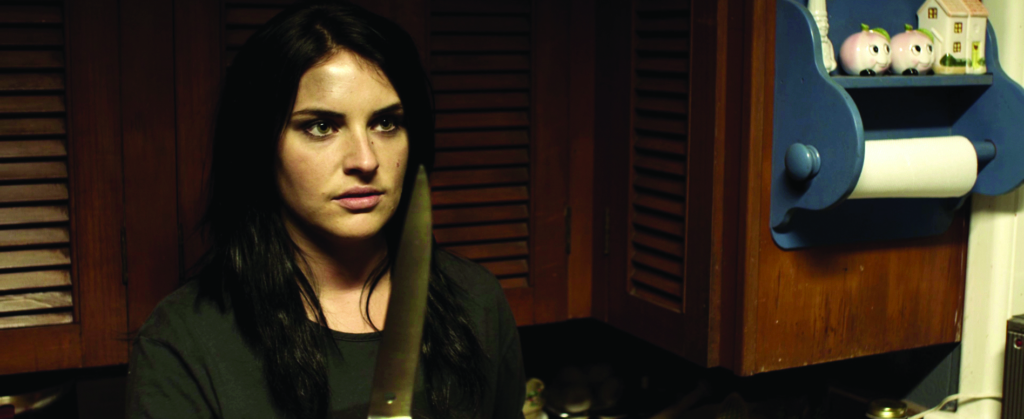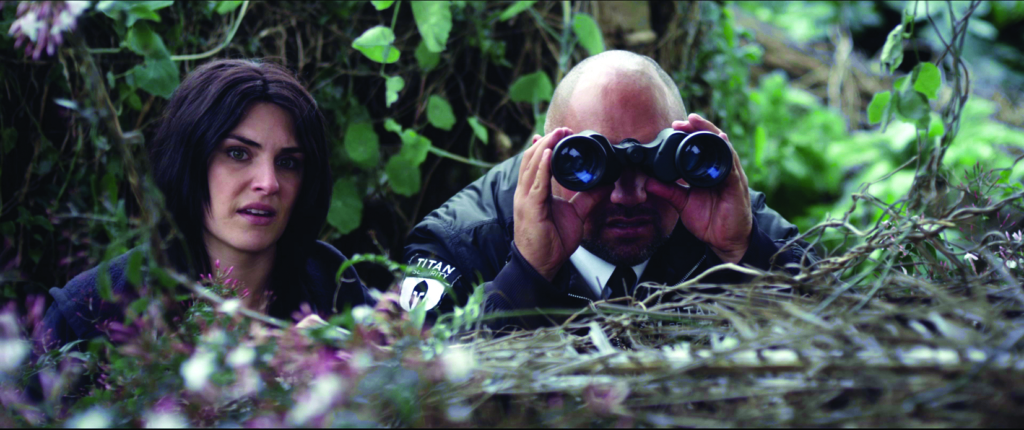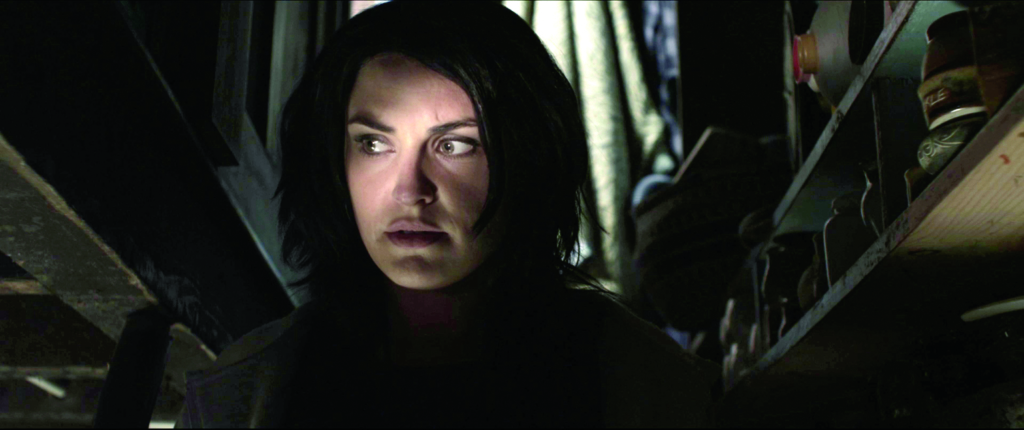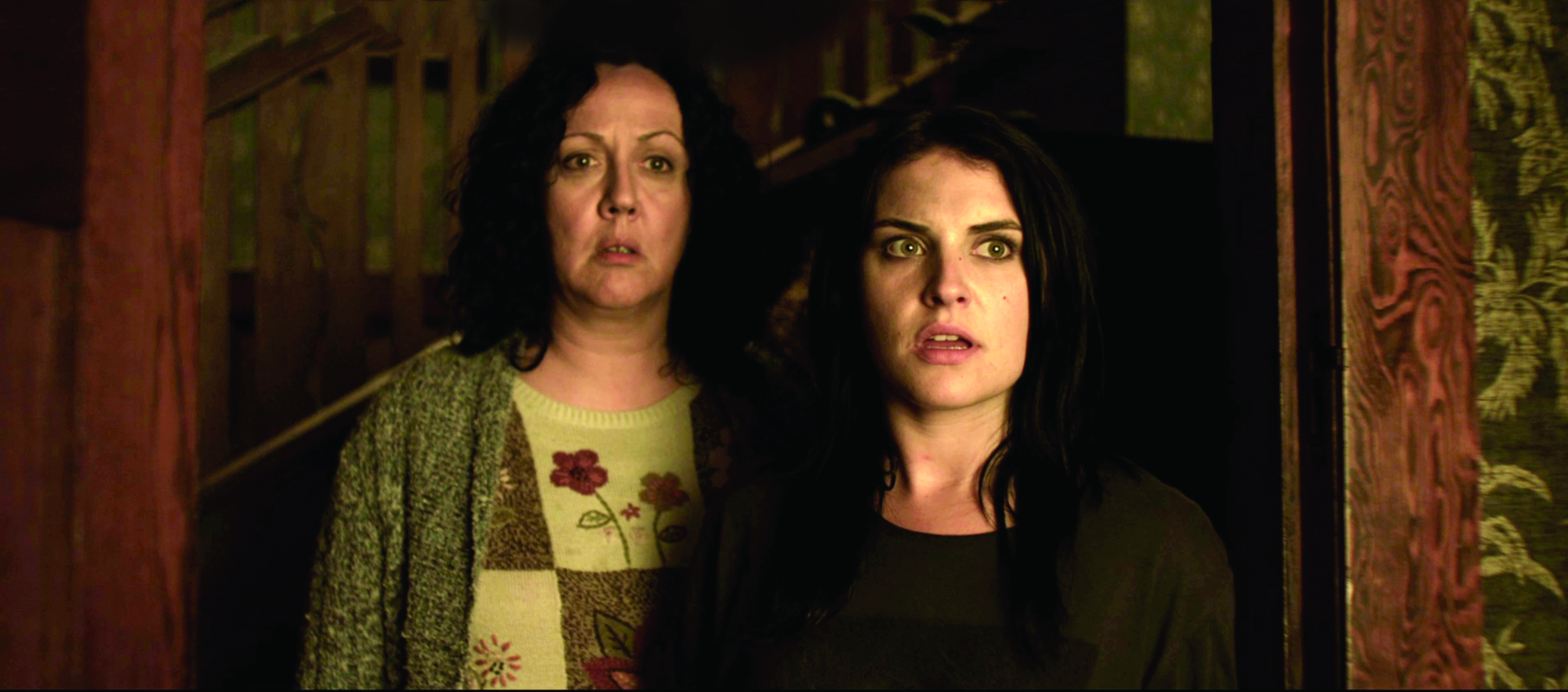The positive popular and critical reception of Jemaine Clement and Taika Waititi’s What We Do in the Shadows (2014) and Gerard Johnstone’s Housebound (2014) vividly illustrates not only that New Zealand horror cinema is at the top of its game, but also that it has achieved this through its sense of humour. Whether it is the classic Bad Taste (1987) by fellow New Zealander Peter Jackson, or the early (non-Kiwi) precedent Bud Abbott and Lou Costello Meet Frankenstein (Charles Barton, 1948), horror–comedy hybrids are certainly not new. In the case of Housebound, the strength of this union stems from Johnstone’s particularly strong utilisation of generic ingredients, which he reinvigorates through his astute awareness of both horror precedents and current audience tastes.
Both critics and viewers have been in full agreement on this front. After premiering at Texas’ prestigious South by Southwest festival in March last year, Housebound was hailed by Shock Till You Drop’s Ryan Turek as ‘the real discovery of the fest’.[1]Ryan Turek, ‘SXSW Review: Housebound Is the Real Discovery of the Fest’, Shock Till You Drop, 11 March 2014, <http://www.shocktillyoudrop.com/news/349377-sxsw-review-housebound/>, accessed 9 February 2015. The film has gone on to win awards at genre festivals like Dead by Dawn in Scotland, the Neuchâtel International Fantastic Film Festival in Switzerland and the Toronto After Dark Film Festival, along with attaining nominations at the Moas and the Fright Meter Awards (including one win at the latter). It has also turned up at key stops on the international genre circuit such as London’s FrightFest, Spain’s Sitges Film Festival and Montreal’s Fantasia International Film Festival, and, on the Australian front, at the Melbourne International Film Festival, the Sydney Underground Film Festival and the Canberra International Film Festival. Reviews have been largely celebratory. Variety’s Richard Kuipers, for instance, emphasises Housebound’s ‘super-smart plotting and confident tonal control’.[2]Richard Kuipers, ‘Film Review: Housebound’, Variety, 4 August 2014, <http://variety.com/2014/film/reviews/film-review-housebound-1201275511/>, accessed 9 February 2015. And for Twitch’s Peter Martin, the film
chops its way through horror-movie tropes with abandon, rejecting most, embracing a few, and conjuring up a couple of new twists […] with a deadly serious tone that is broken at unexpected moments by deliciously deadpan humor.[3]Peter Martin, ‘SXSW 2014 Review: Housebound, a Deadpan, Diabolical, Haunted Thriller’, Twitch, 16 March 2014, <http://twitchfilm.com/2014/03/sxsw-2014-review-housebound.html>, accessed 9 February 2015.
Describing his film as a ‘kitchen sink ghost mystery’,[4]Gerard Johnstone, quoted in Steve Newall, ‘Interview: Gerard Johnstone, Director of Housebound’, Flicks.co.nz, 11 July 2014, <http://www.flicks.co.nz/blog/amazing-interviews/interview-gerard-johnstone-director-of-housebound/>, accessed 9 February 2015. Johnstone carefully balances believable characters with authentic reactions and a light-hearted approach to frights. Housebound is, as he has noted, ‘a horror movie you can take your mum to’.[5]ibid. This relationship between mums and kids is not just a marketing strategy, but also central to both Housebound’s narrative and its thematic dynamics. The film follows the evolutions of nogoodnik Kylie Bucknell (Morgana O’Reilly) and her mother, Miriam (Rima Te Wiata), with whom she is sentenced to spend nine months under house arrest as punishment for her role in a botched robbery. Because of an electronic ankle bracelet that will notify her parole officer, Amos (Glen-Paul Waru), should she attempt to leave the house, Kylie is trapped with Miriam, sparking her regression into selfishness-fuelled teen angst. Dismissive (to the point of nastiness) of her mother’s insistence that the house they are forced to live in together is haunted, Kylie is slowly brought around to Miriam’s point of view after a series of unusual events begins plaguing the house with increasing and alarming regularity.

On the one hand, Kylie’s attempts to convince others (such as her counsellor, Dennis, played by Cameron Rhodes) that the house is haunted are met with suspicion – founded on the assumption that she is either lying or that the sightings are hallucinations, by-products of her long-term substance-abuse issues. But, on the other, she does find surprising allies, most notably Amos, who it turns out is an amateur paranormal investigator. Together with Amos and Miriam, Kylie slowly learns that some of the secrets within the strange house have less supernatural – though still outrageous – explanations. Ultimately, they discover a squatter living within the walls of the house, and uncover Dennis as the true villain of the piece.
Beyond the monstrous mother
Although it has a traditional haunted-house-mystery structure, Housebound’s most effective hook is the relationship between Miriam and Kylie. Emotionally, the film confidently evokes the seemingly ubiquitous memory of the notorious near-primal teenage disdain for parents, and the dislocation of being in the strange liminal domain of adolescence that, for many of us, manifested in eye-rolling and appalling bad manners. Johnstone’s astute identification of the universality of this brand of teenage weirdness affords him a potent foundation on which to build Kylie’s character, which O’Reilly performs with skill.
The film confidently evokes the seemingly ubiquitous memory of the notorious near-primal teenage disdain for parents, and the dislocation of being in the strange liminal domain of adolescence.
It is precisely this chemistry that allows Kylie to be – initially, at least – an admittedly horrible character while still never faltering as a sympathetic protagonist. Te Wiata’s Miriam is similarly complex and nuanced: to Kylie’s credit, Miriam’s constant chatter and unwavering aura of passive-aggressiveness would be difficult to live with at the best of times, let alone 24/7 for nine months straight. But, as Kylie learns as the mystery of the house’s previous – and, unbeknown to her and her mother, current – tenants unfolds, Miriam is also revealed to be brave, intuitive, cunning and wise.
Housebound is therefore as much a love story between a mother and her daughter as it is a work of comedy or horror. And, through these intelligent depictions that privilege the plurality of female subjectivity and the varied experiences of its two central characters, the film also contains a distinctly feminist edge. Johnstone allows both Miriam and Kylie to have flaws, and it’s these flaws that grant their story such powerful momentum. It’s in how they work through these together, in their shared mission to make sense of the strange events occurring in their house, that the film finds its energy, compassion and humour.

The decision to move away from simplistic characterisations was therefore crucial, particularly in the case of Kylie. Transcending the boundaries of confidence and feisty audacity that mark the traditional female horror hero (especially in the case of its most famous incarnation, the slasher film’s Final Girl[6]The trope was analysed at length, and the term Final Girl itself was coined, by Carol J Clover; see Clover, Men, Women, and Chainsaws: Gender in the Modern Horror Film, Princeton University Press, 1992.), Kylie’s toughness might already distinguish her from her protagonist peers from other films, but it also means that we never think she is simply being a ‘silly girl’ once the film’s scares start to escalate. As Johnstone explains to The Austin Chronicle’s Richard Whittaker:
the main reason for a character like Kylie is that I wanted the protagonist to be someone that wouldn’t scare easily. That way, when she does finally fall victim to fear, it’s much more palpable.[7]Gerard Johnstone, quoted in Richard Whittaker, ‘SXSW Gets Housebound’, The Austin Chronicle, 11 March 2014, <http://www.austinchronicle.com/daily/sxsw/2014-03-11/sxsw-gets-housebound/>, accessed 9 February 2015.
From this perspective, comparisons with Eric Red’s 2008 horror film 100 Feet – another work about a woman under house arrest – are worth considering. The titular 100 feet refers to the distance Marnie Watson (Famke Janssen) is permitted to move from her home before her electronic ankle bracelet notifies the police of her breach. Marnie’s house arrest follows her release from prison, where she served time for murdering her abusive husband (Michael Paré) in an act of self-defence. The late husband was a policeman, however, meaning that not only were Marnie’s attempts to get help while he was alive thwarted, but also that she must contend with being harassed by his colleagues, who still believe he was an innocent victim, upon her release. This distressing situation is compounded by the fact that the spirit of her deceased husband has returned from beyond the grave to continue his systematic abuse of his long-suffering wife.
The two films deviate in their tone and in the way they handle their respective subject matter: domestic violence in the case of the darker, bleaker 100 Feet, and mother–daughter relationships in the more light-hearted Housebound. While they are substantially different movies, however, the central plot device that they share – an electronic ankle bracelet – fulfils a similar function in that it allows the film to be (mostly) locked down to a single, primary location. More importantly, the bracelet also establishes the domestic space as a site of horror. This characterisation of the home spans back at least to Alfred Hitchcock’s classic Psycho (1960), but, in the case of both 100 Feet and Housebound, the concept is emphatically feminised. These two movies explore, in very distinct ways, the terror implicit in the traditional notion that a woman’s place is ‘tied’ to the home. Miriam and Kylie’s journey in Housebound is one in which their resilience, courage and newfound respect for each other empower them to transform their once-monstrous domestic sphere into a functional, happy one. Here, everyone – even the very monsters in the wall – are now visible and accepted for who they are. At the end of the film, this is not only Kylie’s victory, but also that of her entire new, weird, happy and perversely functional family.
Towards Housebound
It is not only Housebound’s impressive, intelligently realised gender politics that have garnered the film its remarkable success; in terms of genre construction, it is also crafted with near-molecular precision. A long-time horror fan, Johnstone was informed by classics such as John Hough’s The Legend of Hell House (1973) and Peter Medak’s The Changeling (1980), along with movies like The Goonies (Richard Donner, 1985) and Drag Me to Hell (Sam Raimi, 2009).[8]ibid.; see also Gerard Johnstone, quoted in Dominic Corry, ‘Dominic Corry: Gerard Johnstone on Housebound’, The New Zealand Herald, 13 March 2014, <http://www.nzherald.co.nz/entertainment/news/article.cfm?c_id=1501119&objectid=11218891>, accessed 9 February 2015. These influences intersect neatly with his background in television comedy – he co-created, directed, edited and wrote for the late 2000s New Zealand sitcom The Jaquie Brown Diaries – further solidifying the film’s comedic foundations.
Through these intelligent depictions that privilege the plurality of female subjectivity and the varied experiences of its two central characters, the film also contains a distinctly feminist edge.
Johnstone’s inspirations for Housebound also included paranormal reality-television programs like the Discovery Channel’s Ghosthunters. The assumed ubiquity of the supernatural that underscores such shows is, for Johnstone, a source of real comedy; he notes: ‘There’s something incredibly funny about people who diagnose spiritual infestations like they’re fixing a dishwasher.’[9]Johnstone, quoted in Whittaker, op. cit. But Housebound was born just as much from its textual precedents as it was from the funding limitations that were encountered while bringing the project to the screen: self-contained locations and settings were an essential practicality.[10]Johnstone, quoted in Newall, op. cit. Like many successful horror movies before it – from Night of the Living Dead (George A Romero, 1968) to The Blair Witch Project (Daniel Myrick & Eduardo Sanchez, 1999) – Housebound’s budgetary restraints inspired fresh, exciting ways of generating cinematic spectacle and maintaining suspense rather than hindering creativity.

Whatever ingredients led to the creation of Housebound, there is no denying it has been a potent and highly successful brew. At the heart of its success lies an intelligent script, authentic characters, solid performances and confident direction (even more impressive for a first-time feature-film director); most of all, however, the film has endeared itself to viewers because of its spirit. Housebound avoids what weighs down many other attempts at horror-comedy, especially those with bigger budgets and therefore more pressure for commercial return and a consequent nervousness about taking real risks: smugness. Housebound isn’t trying to ‘fix’ the horror genre by pointing out its weaknesses; rather, it revels in what Philip Brophy captured so eloquently three decades ago with his term horrality: an emphasis on ‘horror, textuality, morality, hilarity’.[11]Philip Brophy, ‘Horrality: The Textuality of the Contemporary Horror Film’, Art & Text, no. 3, 1983, available at <http://www.philipbrophy.com/projects/rstff/Horrality_H.html>, accessed 9 February 2015. Housebound embraces bodily horror in all its carnivalesque glee throughout its moments of glorious splatter, and is determined to make everyday household objects – a cork screw, a laundry basket, even a cheese grater – weapons of extreme blood-spraying violence. As Brophy has noted with films like Creepshow (George A Romero, 1982) and The Evil Dead (Sam Raimi, 1981): ‘the humour is not usually well-crafted but mostly perverse and/or tasteless, so much so that often the humour might be horrific while the horror might be humorous’.[12]ibid.
What Housebound achieves in its scenes of ecstatic and often-gross violence is precisely the thing that Brophy identifies at the heart of horrality:
the humour in a gory scene is the result of the contemporary Horror film’s saturation of all its codes and conventions – a punch line that can only be got when one fully acknowledges this saturation as the departure point for viewing pleasure.[13]ibid.
Inherent to Housebound is a warmth that is found in its characters, in its empowering story about mothers, daughters and their suffocating homes, and in its sincere love of the horror genre. If the growing rank of voices singing the film’s praises is any indication – not to mention that New Line has just announced plans for a US remake[14]Borys Kit, ‘New Line to Remake New Zealand Horror-Comedy Housebound’, The Hollywood Reporter, 11 February 2015, <http://www.hollywoodreporter.com/heat-vision/new-line-remake-new-zealand-772536>, accessed 17 February 2015. – that spirit is utterly contagious.
Endnotes
| 1 | Ryan Turek, ‘SXSW Review: Housebound Is the Real Discovery of the Fest’, Shock Till You Drop, 11 March 2014, <http://www.shocktillyoudrop.com/news/349377-sxsw-review-housebound/>, accessed 9 February 2015. |
|---|---|
| 2 | Richard Kuipers, ‘Film Review: Housebound’, Variety, 4 August 2014, <http://variety.com/2014/film/reviews/film-review-housebound-1201275511/>, accessed 9 February 2015. |
| 3 | Peter Martin, ‘SXSW 2014 Review: Housebound, a Deadpan, Diabolical, Haunted Thriller’, Twitch, 16 March 2014, <http://twitchfilm.com/2014/03/sxsw-2014-review-housebound.html>, accessed 9 February 2015. |
| 4 | Gerard Johnstone, quoted in Steve Newall, ‘Interview: Gerard Johnstone, Director of Housebound’, Flicks.co.nz, 11 July 2014, <http://www.flicks.co.nz/blog/amazing-interviews/interview-gerard-johnstone-director-of-housebound/>, accessed 9 February 2015. |
| 5 | ibid. |
| 6 | The trope was analysed at length, and the term Final Girl itself was coined, by Carol J Clover; see Clover, Men, Women, and Chainsaws: Gender in the Modern Horror Film, Princeton University Press, 1992. |
| 7 | Gerard Johnstone, quoted in Richard Whittaker, ‘SXSW Gets Housebound’, The Austin Chronicle, 11 March 2014, <http://www.austinchronicle.com/daily/sxsw/2014-03-11/sxsw-gets-housebound/>, accessed 9 February 2015. |
| 8 | ibid.; see also Gerard Johnstone, quoted in Dominic Corry, ‘Dominic Corry: Gerard Johnstone on Housebound’, The New Zealand Herald, 13 March 2014, <http://www.nzherald.co.nz/entertainment/news/article.cfm?c_id=1501119&objectid=11218891>, accessed 9 February 2015. |
| 9 | Johnstone, quoted in Whittaker, op. cit. |
| 10 | Johnstone, quoted in Newall, op. cit. |
| 11 | Philip Brophy, ‘Horrality: The Textuality of the Contemporary Horror Film’, Art & Text, no. 3, 1983, available at <http://www.philipbrophy.com/projects/rstff/Horrality_H.html>, accessed 9 February 2015. |
| 12 | ibid. |
| 13 | ibid. |
| 14 | Borys Kit, ‘New Line to Remake New Zealand Horror-Comedy Housebound’, The Hollywood Reporter, 11 February 2015, <http://www.hollywoodreporter.com/heat-vision/new-line-remake-new-zealand-772536>, accessed 17 February 2015. |





